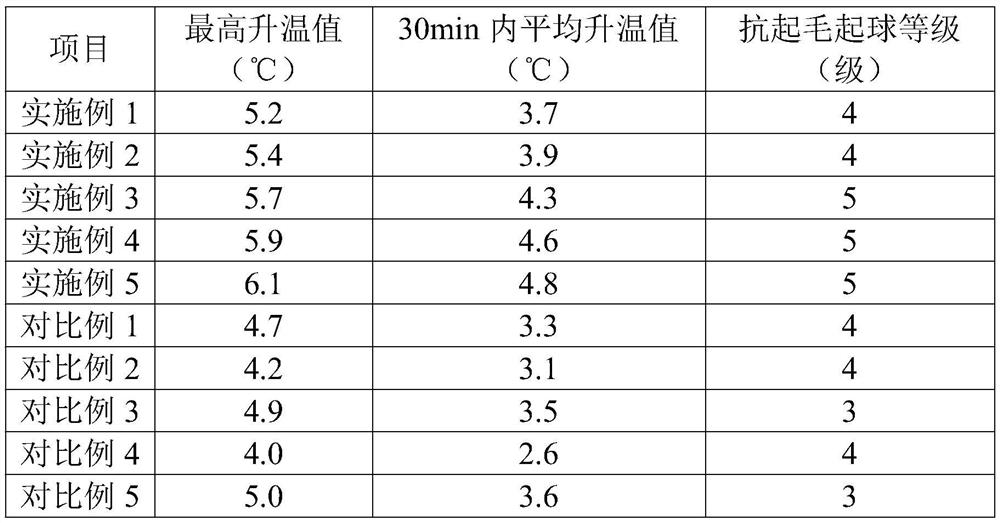Heating anti-pilling fabric
A technology of heating fibers and raw materials, applied in the field of textile fabrics, can solve the problems of poor performance stability, poor compatibility, easy delamination, etc., and achieve the effects of excellent heating function, good comprehensive performance and comfortable wearing.
- Summary
- Abstract
- Description
- Claims
- Application Information
AI Technical Summary
Problems solved by technology
Method used
Image
Examples
Embodiment 1
[0035] A heating and anti-pilling fabric is characterized in that it is woven from warp yarns and weft yarns; the warp yarns are heating fibers and wool fiber blended yarns; the weft yarns are viscose fibers and functional heating fiber blended yarns; The functional heating fiber is made of the following raw materials in parts by weight: 60 parts of polyester chips, 2 parts of opal powder, 3 parts of graphene oxide fiber, rare earth oxide La 2 Zr 2 o 7 1 part of nanostructure fiber, 2 parts of hydroxyl-terminated nano-hybrid hyperbranched polymer, 5 parts of epoxy-terminated amine group hyperbranched poly(amine-ester), 1 part of surface-coated butyl stearate, terephthalic acid 0.5 part of diallyl ester, 0.3 part of initiator, and 1 part of coupling agent.
[0036] The mass ratio of the heating fiber and the wool fiber is 1:2; the heating fiber is fiber.
[0037] The mass ratio of the viscose fiber and the functional heating fiber is 1:2; the viscose fiber is bamboo charco...
Embodiment 2
[0044] A heating and anti-pilling fabric is characterized in that it is woven from warp yarns and weft yarns; the warp yarns are heating fibers and wool fiber blended yarns; the weft yarns are viscose fibers and functional heating fiber blended yarns; The functional heating fiber is made of the following raw materials in parts by weight: 63 parts of polyester chips, 2.5 parts of opal powder, 4 parts of graphene oxide fiber, rare earth oxide La 2 Zr 2 o 7 1.5 parts of nanostructure fiber, 2.5 parts of hydroxyl-terminated nano-hybrid hyperbranched polymer, 6 parts of epoxy-terminated amine-based hyperbranched poly(amine-ester), 1.5 parts of surface-coated butyl stearate, terephthalic acid 0.7 parts of diallyl ester, 0.35 parts of initiator, and 1.2 parts of coupling agent.
[0045] The mass ratio of the heating fiber to the wool fiber is 1:2.2; the heating fiber is Thermogear fiber.
[0046] The mass ratio of the viscose fiber and the functional heating fiber is 1:2.2; the vi...
Embodiment 3
[0051] A heating and anti-pilling fabric is characterized in that it is woven from warp yarns and weft yarns; the warp yarns are heating fibers and wool fiber blended yarns; the weft yarns are viscose fibers and functional heating fiber blended yarns; The functional heating fiber is made of the following raw materials in parts by weight: 65 parts of polyester chips, 3.5 parts of opal powder, 4.5 parts of graphene oxide fiber, rare earth oxide La 2 Zr 2 o 7 2 parts of nanostructured fiber, 3 parts of hydroxyl-terminated nano-hybrid hyperbranched polymer, 7.5 parts of epoxy-terminated amine group hyperbranched poly(amine-ester), 2 parts of surface-coated butyl stearate, terephthalic acid 1 part of diallyl ester, 0.45 parts of initiator, and 1.5 parts of coupling agent.
[0052] The mass ratio of the heating fiber to the wool fiber is 1:2.5; the heating fiber is Renaissa fiber.
[0053] The mass ratio of the viscose fiber and the functional heating fiber is 1:2.5; the viscose ...
PUM
| Property | Measurement | Unit |
|---|---|---|
| particle size (mesh) | aaaaa | aaaaa |
| diameter | aaaaa | aaaaa |
| diameter | aaaaa | aaaaa |
Abstract
Description
Claims
Application Information
 Login to View More
Login to View More - R&D
- Intellectual Property
- Life Sciences
- Materials
- Tech Scout
- Unparalleled Data Quality
- Higher Quality Content
- 60% Fewer Hallucinations
Browse by: Latest US Patents, China's latest patents, Technical Efficacy Thesaurus, Application Domain, Technology Topic, Popular Technical Reports.
© 2025 PatSnap. All rights reserved.Legal|Privacy policy|Modern Slavery Act Transparency Statement|Sitemap|About US| Contact US: help@patsnap.com

